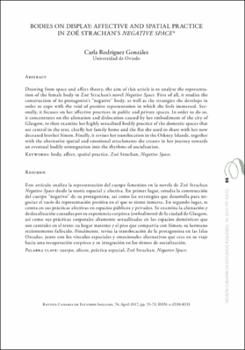Bodies on Display: Affective and Spatial Practice in Zoë Strachan’s Negative Space
Fecha
2017Resumen
Este artículo analiza la representación del cuerpo femenino en la novela de Zoë Strachan Negative Space desde la teoría espacial y afectiva. En primer lugar, estudia la construcción del cuerpo “negativo” de su protagonista, así como las estrategias que desarrolla para negociar el vacío de representación positiva en el que se siente inmersa. En segundo lugar, se centra en sus prácticas afectivas en espacios públicos y privados. Se examina la alienación y deslocalización causadas por su experiencia corpórea (embodiment) de la ciudad de Glasgow, así como sus prácticas corporales altamente sexualizadas en los espacios domésticos que son centrales en el texto: su hogar materno y el piso que compartía con Simon, su hermano recientemente fallecido. Finalmente, revisa la translocación de la protagonista en las Islas Orcadas, junto con los vínculos espaciales y emocionales alternativos que crea en su viaje hacia una recuperación corpórea y su integración en los ritmos de socialización. Drawing from space and affect theory, the aim of this article is to analyse the representation of the female body in Zoë Strachan’s novel Negative Space. First of all, it studies the construction of its protagonist’s “negative” body, as well as the strategies she develops in order to cope with the void of positive representation in which she feels immersed. Secondly, it focuses on her affective practices in public and private spaces. In order to do so, it concentrates on the alienation and dislocation caused by her embodiment of the city of Glasgow, to then examine her highly sexualised bodily practice of the domestic spaces that are central in the text, chiefly her family home and the flat she used to share with her now deceased brother Simon. Finally, it revises her translocation in the Orkney Islands, together with the alternative spatial and emotional attachments she creates in her journey towards an eventual bodily reintegration into the rhythms of socialisation.





